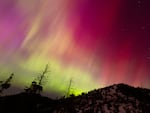
The Northern Lights fill the sky at the Bogus Basin ski resort in Boise, Idaho, on Saturday.
Kyle Green / AP
The solar storm that pushed the Northern Lights much farther south than normal is expected to continue Sunday night and possibly into the week, forecasters say, but the impact won't be as strong as in previous days.
Meanwhile, while the storm had an impact on power grids, telecommunications and global positioning systems, only minor disruptions were reported as the storm sent powerful electromagnetic pulses toward Earth.
The series of powerful coronal mass ejections that arrived on earth on Friday produced dazzling shows across the Northern Hemisphere on Friday and Saturday for places that don't normally see them, including parts of China, Europe and the United States.
Severe to extreme geomagnetic storming is possible again later today... pic.twitter.com/A2eqz5c38B
— NOAA Space Weather Prediction Center (@NWSSWPC) May 12, 2024
Solar activity produces ejections of energized particles that interact with gasses in the Earth's atmosphere and produce auroras that hover around its poles. They're known as the aurora borealis around the North Pole and the aurora australis around the South Pole.
Friday and Saturday's storms expanded sightings of the Southern Lights into New Zealand, Australia, Chile and Argentina.
In the U.S., viewings were reported as far south as Alabama and Georgia as well as northern California. The Space Weather Prediction Center (SWPC) said the powerful geomagnetic storm will become more intense through Sunday night and the aurora will become visible again at lower latitudes.
The solar storm's origin is connected to a cluster of sunspots on the sun's surface. The spots are filled with magnetic fields that can act as slingshots, sending large amounts of charged particles toward Earth. The events are known as coronal mass ejections (CMEs) and are more common toward the peak of the sun's 11-year solar cycle, in 2025.
Related: South looks north, as solar storm brings auroras
The particles will most often miss the Earth, but now, the National Oceanic and Atmospheric Agency said several of the ejections headed directly for Earth.
The storm reached G5 — or "extreme" — levels on Friday and Saturday, causing vivid green, pink and purple lights to be seen. Another burst of particles is predicted to reach Earth on Sunday, producing G4 — or "severe" — levels, and possibly reaching G5 conditions again into early Monday.
While the extreme storms create conditions for the lights to expand far away from the poles, those conditions can disrupt electrical power grids and cause blackouts and degrade satellite communications and navigation systems.
A similar event in 2003 knocked out power in parts of Sweden and damaged electrical transformers in South Africa.
The SWPC received reports of power grid irregularities, disrupted high-frequency radio communications, degraded GPS, and modified spacecraft operations during Friday and Saturday's G5 storm, said Lt. Bryan Brasher, a project manager with the agency.
While power grids worldwide were highly stressed during the G5 storm, the SWPC did not receive notice of any damage, Brasher said.
"We received reports of degraded radio communications from aviation and marine operators," Brasher said in an email to NPR. "We have not received reports of disrupted satellite communications."
Related: Strong solar storm could disrupt communications and produce northern lights in US
Brasher said effects on GPS were noticeable during the storm.
"We heard of issues with the use of precision GPS in agriculture from various parts of the Midwest and both American and European satellite navigation augmentation systems registered notable (but not necessarily impactful) changes in position accuracy," he said.
The storm is less likely to have the same impact in the coming days as it did on Friday and Saturday, said SWPC Service Coordinator Shawn Dahl.
"The bulk of the material will likely pass ahead of Earth, however, the interplanetary space is very disturbed still and even just the flanking edge of the latest CMEs will likely result in strong-severe conditions," he said.
Copyright 2024 NPR. To see more, visit https://www.npr.org.